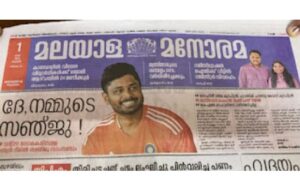The Gangaur Festival, celebrated with pomp and pageantry by the women of Rajasthan, coincided with the International Women’s Day this year
 By Rajeshwari Kalyanam
By Rajeshwari Kalyanam
It is that time of the year again in Udaipur when the spring is rejoiced, and the harvest is celebrated while praying to the Gods for marital bliss and health of the loved ones. The Gangaur Festival, which began on March 8 this year, culminates with the three-day revelry starting on March 24.
The evening festivities of Gangaur began with royal procession from Tripoliya, the historic gates of the City Palace, Udaipur, with women carrying the highly adorned Gan and Gauri idols to the Rameshwar Ghats. While the clay idols are immersed in the Pichola lake, the wooden ones are washed to be brought back home. This is followed by processions and celebrations with dance and music across the city.
The Gangaur Festival in Udaipur – the celebration of spring, harvest and marital bliss, is a crowd puller for national and international tourists. For the locals and the royal family, this Mewar festival is a living heritage followed with much devotion and fervor every year.
Spring colours come alive during the annual festival, whose name is derived from Gana or Shiva and Gaur or Gauri, his consort Parvathi. Womenfolk in Rajasthan worship them as the symbol of love, abundance and fruitfulness. From the royal folk to the commoners, the cultural richness of the region reverberates through song, dance and prayer for over a fortnight concluding on the third day of the month of Chaitra.

The festival is more than a celebration – it is the reflection of a way of life, a spectacular event that has on display the entire tapestry of culture intrinsic to the region and hoary traditions unchanged over time.
A detailed description of the Gangaur festival is available to us through the eyes of Col. Tod, who first met Maharana Bheem Singh (1778-1828) in the outer courtyard of the temple of Shree Eklingi. He was then, the Commander of the Escort with Daulat Rao Scindia’s perambulating court and his meeting with Maharana sparked off his interest in the region. He spent a great deal of time and resources in the collection of historical documents, inscriptions, bardic paintings and genealogies of the Rajput houses and paintings of Rajasthan.
Col Tod
Col Tod recorded the celebration as seen by him as far back as c. 1820. “Every turret, and balcony is crowded with spectators, from the palace to the water’s edge and the ample flight of stairs, which intervene from the Tripoliya or triple portal to the boats in a dense mass of females in variegated robes whose scarves but half conceal their ebon tresses adorned with the rose and the jasmine. A more imposing or more exhilarating sight cannot be imagined when the entire population of the city thus assembled for the purpose of rejoicing, the countenance of every individual from the prince to the peasant, dressed in smiles” he says.
The Gangaur Festival, which is held to signify Parvati’s visit to her parental home after her wedding and her return after seeking their blessings, is said to have been a regular feature since the pre-historic times and is significant among the festivities in Mewar.
While married women pray for the longevity of their husbands, unmarried women are said to pray to goddess Gauri to secure a good husband, and over the time the festival has become an important part of culture. Many of the traditions held here including offering prayers by the lakeside and singing and dancing to circular movements have commonalities with similar festivals in other regions in India.

The Gangaur paintings from the City Palace Museum, Udaipur, some of which are on display as part of an ongoing exhibition at the Smithsonian National Museum of Asian Art, Washington DC, are stunning in their detail as they record celebrations and capture people across the spectrum in vibrant hues. Normal houses, magnificent havelis and temples of the town shown in jumbled multiple perspectives with a dense colourful crowd of women thronging the vertical main street carrying images of Shiva and Gauri are indeed a feast to the eyes.
The Maharana with his nobles, ministers and attendants seated in their barges and boats moored beside the ghats watching women carry images of Shiva and Gauri from their shrines to the lakeside, singing and dancing prayerfully are depicted in fine detail.
Lake Pichola
Pictures of people being rowed around the northern bank of Lake Pichola visiting other images of goddess Gauri are a sight to behold as the artiste captures various processions and sights of the festival.
The grand fireworks over the lake marking the conclusion of the festival, floating oil lamps on the lake and the evocation of images associated with Gangaur festival remain one of the most impressive visuals that one gets to see not just in the paintings collection but also from old photographic collection of the Museum. They are a reminder of the antiquity of the festival, which continues with the same pomp and grandeur to this day.
Udaipur even has a ghat named after the Gangaur festival called Gangaur ghat or Gangori ghat on Lake Pichola, which becomes central to the celebrations involving life around it.
The Gangaur paintings which are an important link to the past and show the patronage of Royalty and the enthusiastic participation of various sections of city in ancient times are records that convey more than words and a history that is to be cherished. Their exhibition in faraway lands serves to introduce them to larger audiences and inspire awe and admiration and appreciation for Indian culture.
(Pictures provided by the author)
The writer, a senior journalist, is the Chief Editor of www.fridaywall.com, FW Media & Content Solution












More Stories
Every Keralite’s pride: How Kerala is celebrating Sanju Samson’s selection in World Cup squad
Sufiana Lived His Heart: A Daughter Reminisces
For drivers, the original issue of hit-and-run still remains unresolved